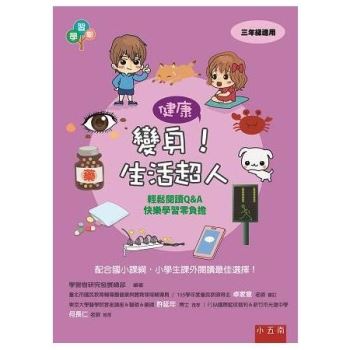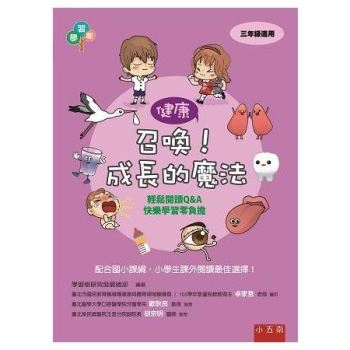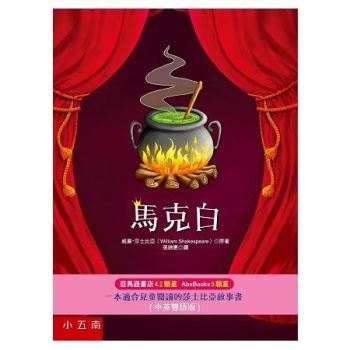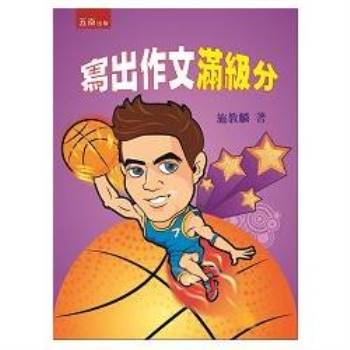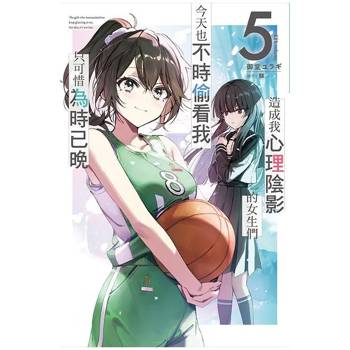| FindBook |
有 3 項符合
光大傳承─南加州華人三十年史話:第三卷(全四卷,國際英文版)的圖書 |
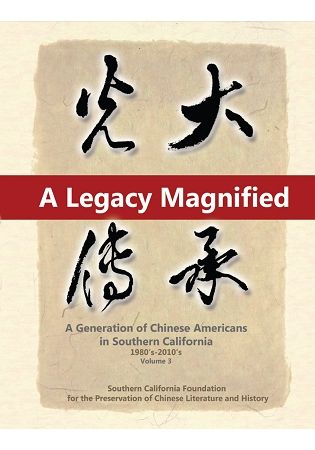 |
光大傳承─南加州華人三十年史話:第三卷(全四卷,國際英文版) 作者:陳十美(總編輯) 出版社:漢世紀數位文化EHGBooks 出版日期:2017-12-01 規格:29.74cm*21.59cm (高/寬) / 平裝 / 480頁 |
| 圖書館借閱 |
| 國家圖書館 | 全國圖書書目資訊網 | 國立公共資訊圖書館 | 電子書服務平台 | MetaCat 跨館整合查詢 |
| 臺北市立圖書館 | 新北市立圖書館 | 基隆市公共圖書館 | 桃園市立圖書館 | 新竹縣公共圖書館 |
| 苗栗縣立圖書館 | 臺中市立圖書館 | 彰化縣公共圖書館 | 南投縣文化局 | 雲林縣公共圖書館 |
| 嘉義縣圖書館 | 臺南市立圖書館 | 高雄市立圖書館 | 屏東縣公共圖書館 | 宜蘭縣公共圖書館 |
| 花蓮縣文化局 | 臺東縣文化處 |
|
|
- 圖書簡介
A Legacy Magnified: A Generation of Chinese Americans in Southern California, 1980’s-2010’s (南加華人三十年史話英文版) is a monumental publication jointly authored by a team of renowned group of writers consisting of 17 chapters, nearly 1 million words, and more than 1,300 photographs, many of which are collected from historical archives. It is an unprecedented endeavor undertaken by more than 500 volunteers who were privileged to have witnessed the drastic and amazing transformation of Chinese American communities in Southern California during the critical three decades, from the 1980’s to the 2010’s.
This handsome volume encompasses an historical account of multifarious realms of community development, including various aspects of culture, history, political participation, economic growth, businesses, education, language, sports, mass media, science and technology, scholarly research, literature, music, dance, theatre and other performing arts, among other subjects.
This book is substantial, and is dedicated to “All Chinese of past, present, and future generations who contribute to the world culture by incorporating the quintessence of Chinese civilization and their heritage.”
Postscript
A Crystal Formed Out of 900,000 Beads of Sweat
Following 1,460 days of toil and labor, an estimated 1,460 person-visits to the small meeting room of the American-East Asian Cultural and Educational Foundation, and consuming over 1,460 boxes of bento, A Legacy Magnified: A Generation of Chinese Americans in Southern California, 1980’s-2010’s, containing over 900,000 Chinese characters, is finally available in print.
In the past 30 years, the Chinese in Southern California excelled in their respective fields of expertise and in all realms of activities, including culture, politics, economy, education, sports, mass media, business, science and technology, academics, arts, literature, music, dance, drama, food, and service industry. They have thrived and continue to flourish. To write a book like A Legacy Magnified covering all these aspects with limited human and financial resources and working under time constraints would have been quite impossible.
Fortunately, when I proposed to write a book like this, I received warm responses from the Chinese community. More than a hundred individuals signed up as volunteers, and donations streamed in. I was greatly encouraged. While I was excited about the prospect, I felt that the onus of my responsibility was heavy. In order to live up to the expectations of my supporters, I treaded with fear and trepidation as if I was walking on thin ice. I sketched the book’s plan and structure and proactively commenced the work.
Initially I thought we could publish the book after collecting enough articles and material within four months. Unexpectedly, however, we continue to receive more and more material from all sources. It has taken us four years, instead, to produce this volume after we have incorporated all available information and data. As a result of the enthusiastic response from the Chinese American communities, the original plan to divide the book into fourteen chapters in approximately 60,000 Chinese characters, was once expanded to about 2,000,000 characters. We have managed, finally, to reduced the book to approximately 900,000 characters in seventeen chapters in its current form and shape. Dr. San-pao Li, Professor Emeritus, a historian by profession, thoughtfully offered the capstone of this book with its encompassing title Guang Da Chuan Cheng 光大傳承(Legacy Magnified), highlighting the historical significance of this publication.
During this period of over four years of research, exploration, and visitations, we solicited and received more than 300 articles. We collected oral history of over 500 individuals. In addition, we also collected over 200 books and publications related to our subject, over 1,000 newspaper clippings, over 1,000 questionnaires from Chinese American families, over 1,000 precious photos, and more than 2,000 pieces of contact information of outstanding personalities in the Chinese American community. In the meanwhile, we developed and launched a new web site that will enable us to continue to update our content in the future. In the process of compiling this work, we received support from University of California, Los Angeles besides the Chinese community. UCLA East Asian Library launched a special project and employed additional staff to further document the oral histories of some eminent Chinese Americans in order to archive them as raw research material for in-depth scholarly studies in the future.
As I was sorting out the nearly 2,000 telephone numbers collected, I recall how tirelessly we went out of the way to search for relevant information. I recall how our editorial team collected, reviewed and edited the manuscripts contributed by over 100 outstanding Chinese American, and how assiduously they reconciled the innumerable factual contradictions, verified, sorted out, complied, reviewed and fixed the errors. I recall how our volunteers rendered their service so willingly and selflessly. Touched by the dedication of all these individuals, I became frequently oblivious of time, skipping meals and sleep. I recall the many warm and thoughtful encouragements offered as well as skepticisms of all kinds. I recall getting up in the countless early mornings, still exhausted and fatigued, yet with strong conviction and faith, I struggled to continue the tasks before me. I recall the four years during which I neglected inadvertently my family and many of the administrative responsibilities of the school of which I am the principal. I recall the unparalleled commitment displayed by my fellow workers in the modest editorial staff office located at the back of the Sunshine Education Center. This project of immense scope is now finally completed. The 900,000 Chinese characters contained in this book represent, indeed, the crystallization of 900,000 beads of sweat. While my heart dances with joy, I find myself in fear and trepidation. Although I feel that I have exhausted my utmost, the limited space available in this book cannot possibly comprehensively document every marvelous detail of the splendid history of the Chinese immigrants in Southern California during the past half century. Errors are understandably unavoidable, but what makes me feel uneasy most is the possibility of inadvertent omissions of much of the accomplishments of many outstanding individuals. The only comfort is that we have developed and launched a website through which we can always supplement and update information received in the future. I hope earnestly that our readers here and abroad will continue to offer constructive comments and suggestions.
Finally, before this book goes to print, I wish to extend my profound gratitude to all individuals and Chinese American organizations and their leading officers for their guidance, suggestions as well as their financial contributions during the entire process of its preparation and production. The Chinese language media spared no space to report to their readers or viewers details of every stage of this project. I remain deeply touched. The American-East Asian Cultural and Educational Foundation and the North America Chinese Writers’ Association in Los Angeles北美洛杉磯華人作家協會, of both which I am a member, contributed significantly during the initial phase of this project. The unstinting support that I have received from the board members of the Southern California Foundation for the Preservation of Chinese Literature and History Inc.南加華人文史保存基金會, all of whom are eminent individuals, the sustained encouragement of all the teachers, students, and their parents alike at Sunshine Education Center, and the generous support from my family and friends will forever be remembered. Last but not the least, I would like to acknowledge with profound gratitude and appreciation the dedication, commitment, and diligent effort of each and every participant in this project and its staff. My sincerest gratitude to you all!
May Chen
November 31, 2013
Los Angeles, CA - 作者簡介
南加華人文史保存基金會(Southern California Foundation for the Preservation of Chinese Literature and History)
The Foundation was established on January 20, 2013. Its purpose was to continue the effort of American East Asian Culture and Education Center to bring to conclusion the publication of A Legacy Magnified: A Generation of Chinese American in Southern California, 1980’s-2010’s with additional expertise. It is our hope to continue to document the successes and accomplishments achieved by Chinese Americans in the Southland during that past three decades. Founding members of the Board of Directors included Michael G. Cheung, Karen Chen, Paul Shao-Han Sher, Evans Y. Lam, Jin-jen Lee, Grace Hu, Sandy Ho, David H. Ma, Cathy Kit-yee Choi, Frances Wang, William S. Chin, Shiyun Chung, and honorary members such as Huibao Xu, Karen Kuo-Limb, Ming Bin Kuo, Joseph Y. Hsu, Ellen Fu, Leo Chu, Richard Y. Koo, Tung Wang, Matthew Yuan-Ching Lin, and Tom Tsong-ming Liaw, all leaders of various community organizations and associations. They each rendered significant service and support. The roles of the Board members are rotated annually. The current members are: Evans Y. Lam (President), May Chen (Chief Executive Officer), Karen Chen (VP), Michael G. Cheung (VP), Paul Shao-Han Sher (Treasurer), Shiyun Chung (Secretary), Sandy Ho (PR), William S. Chin (PR), and San-pao Li, Jin-jen Lee, Yunding Li, Jinping Duan, Cathy Kit-yee Choi, Frances Wang, Grace Hu, Suellen Cheng, and Karen Kuo-Limb.
南加華人文史保存基金會(Southern California Foundation for the Preservation of Chinese Literature and History)
The Foundation was established on January 20, 2013. Its purpose was to continue the effort of American East Asian Culture and Education Center to bring to conclusion the publication of A Legacy Magnified: A Generation of Chinese American in Southern California, 1980’s-2010’s with additional expertise. It is our hope to continue to document the successes and accomplishments achieved by Chinese Americans in the Southland during that past three decades. Founding members of the Board of Directors included Michael G. Cheung, Karen Chen, Paul Shao-Han Sher, Evans Y. Lam, Jin-jen Lee, Grace Hu, Sandy Ho, David H. Ma, Cathy Kit-yee Choi, Frances Wang, William S. Chin, Shiyun Chung, and honorary members such as Huibao Xu, Karen Kuo-Limb, Ming Bin Kuo, Joseph Y. Hsu, Ellen Fu, Leo Chu, Richard Y. Koo, Tung Wang, Matthew Yuan-Ching Lin, and Tom Tsong-ming Liaw, all leaders of various community organizations and associations. They each rendered significant service and support. The roles of the Board members are rotated annually. The current members are: Evans Y. Lam (President), May Chen (Chief Executive Officer), Karen Chen (VP), Michael G. Cheung (VP), Paul Shao-Han Sher (Treasurer), Shiyun Chung (Secretary), Sandy Ho (PR), William S. Chin (PR), and San-pao Li, Jin-jen Lee, Yunding Li, Jinping Duan, Cathy Kit-yee Choi, Frances Wang, Grace Hu, Suellen Cheng, and Karen Kuo-Limb.
總編輯陳十美,May Chen, Editor-In-Chief
•President of American East Asian Culture & Education Foundation
•Founder and Chief Executive Officer of Southern California Foundation for the Preservation of Chinese Literature and History
•President of North America Chinese Writers' Association, Los Angeles
•Principal of Sunshine Education Center
•Publisher of So Cal Chinse Community, 1980-1989
•Founded Huaxing Academy and Sunshine Education Center in 1987
May Chen has resided in the United States for over three decades, during which she has spared no effort in engaging herself in a wide spectrum of activities promoting Chinese culture and civilization. She has dedicated her entire adult life to educate others about China’s cultural heritage. - 目次
Table Of Contents
Table Of Contents i
Preface I I
Preface II IV
Preface III VII
Preface IV X
Introduction XV
CHAPTER NINE The Inheritance of Chinese Culture and Literature 1
I. The Writing Careers and Different Destinies of the Two Canonical Writers 1
1. Eileen Chang--Splendorous and Yet Bleak Shadow of Life 1
2. C. Y. Lee--Splendid and Glorious Achievement in Literature 3
II: Resplendent and Colorful Chinese Community Gardens of Literature 5
1. The Garden of Literature Media Support 6
2. Literary Organizations and Prolific Literary Creation 10
2.1 North American Chinese Writers Association of Southern California 10
2.2 North America Chinese Writers’ Association LA 11
2.3 Los Angeles Chinese Writers' Association 18
2.4 North American San Fernando Valley Chinese Writers’ Association 23
2.5 The Way Literary Association 25
2.6 Overseas Taiwanese Pen Club 27
2.7 Taiwanese American Pen Club 28
3. Literary Training Organizations and Flourishing Reading Groups in Various Regions 29
4. Poets’ Societies and Refined Creative Works 30
4.1 New World Poetry 30
4.2 Fengti Poets’ Club 33
4.3 Plum Blossom Poets’ Society 35
4.4 Wen Fong Poetry Club 35
4.5 Dragon-Carving Poets’ Society 36
5. The Rise of Zhiqing Literature in China 36
6. “Anti-Japanese Literature” in Southern California 38
7. English Literature Published by the Chinese 42
III. Book Publishing and Translation Industry in Southern California -- A Bridge to Literature 47
1. A Small Number of Publishers 48
2. Closely Connected Business of Chinese Language Bookstores 49
2.1 The Early Bookstores in the City of Monterey Park 49
2.2 Once Prosperous Bookstore in Chinatown 51
2.3 The Bookstores in Other Regions of San Fernando Valley 52
2.4 The Rise of Digital Media Will Inevitably Replace Paper Publishing 53
2.5 The World Journal Sponsors an Activity “Everybody Comes and Writes a Book” 53
3.Exceptionally Eminent Translators 54
IV. Important Conferences on Literature and Exchanges among the Literary Circles in mainland China and Taiwan 55
1. Important Individual and Organized Activities 56
1.1 So Cal Chinese Community News Sponsored the first Symposium on Bo Yang’s Literature in Southern California 56
1.2 The Second Annual Meeting of Overseas Chinese Women Writers Aossiciation 58
1.3 Rape of Nanking: The Forgotten Holocaust of World War II by Iris Chang 58
1.4 The Second Annual Meeting of North America Chinese Writers’ Association, Los Angeles 60
1.5 The Fourth Annual Meeting of World Association of Chinese Writers 60
1.6 Coffee Fragrance in Literature 61
1.7 The Book Launch for Lan Wang’s 100th Reprint of The Blue and the Black 61
1.8 Kwang-Chung Yu’s Poetry Recitation 62
1.9 Chun-ming Hwang’s and Ang Li’s Lecture Tour in Los Angeles 62
1.10 Hsien-yung Pai’s Talk on “My Father and the Republic of China” 63
2. Exchanges and Interactions with the Literary Circles in mainland China and Taiwan 64
2.1 Writers in Southern California Were Invited to Give Talks in Canada and Beijing 64
2.2 The Responsibility of Continuing the Overseas Literary Tradition Rests with Our Generation 65
V. The Conditions for the Chinese in Southern California to Transmit Cultural Heritage in Various Fashions 66
1. Overseas Chinese’s Home--Cultural Service Organizations for the Overseas Chinese in Southern California 69
1.1 Cultural and Educational Service Centers for Overseas Chinese 69
1.2 The China Press --the Center of Chinese Cultural Development 71
1.3 Chinese-American Associations in Southern California that Spread Chinese Culture 72
2. Gem of the Earth and Treasures of the Nature--The Museums on Chinese History and Culture in Southern California 73
2.1 Chinese American Museum 74
2.2 Bowers Museum 75
2.3 Pacific Asia Museum 78
2.4 Alhambra Historical Society Museum 79
2.5 San Diego Chinese Historical Museum 80
3. In Time, We Effect a Change--The Organizations and Activities for Promoting Traditional Chinese Culture in Southern California 80
3.1 Chinese Culture Center at California State University, Los Angeles 80
3.2 Chinese Cultural Revival Association in Southern California 81
3.3 The Society for Confucian Studies of America 83
3.4 American East Asian Cultural and Educational Foundation 88
3.5 Southern California Foundation for the Preservation of Chinese Literature and History 89
3.6 The Institutes and Academies Promoting Chinese Language and Culture 92
4. In Memory of the Late Veteran Chinese Cultural Promoters in Southern California 100
VI. Promoters of New Overseas Immigrant Literature 103
1. Carrying the Influence of Home Culture and Clashing with Experience of Foreign Land 103
2. Possessing Multi-Cultural Resources with Border-Crossing Perspectives 104
3. Studying and Thinking to Attain Deep Comprehension and Expressiveness 105
CHAPTER TEN Notable Accomplishments in the Arts 107
I. Chinese Calligraphy, Seal Cutting, the Arts of Pottery, Stone and Painting 107
1. Noted Chinese Calligraphers in Southern California: Fangwey Yen, Terry Yuan and Howard Shih 107
2. Noted Seal Cutters and the Artists in Pottery and Stone 110
2.1 Highly Skillful Veteran Seal Cutters: Disheng Tang, Wenyuan Chen, Shang Delin and Qingnian Tang 110
2.2 Noted Artists in Pottery and Stones: Oliver Lin, Fenghsiung Liu and Ruiqi Wang 113
3. Traditional Chinese Paintings that Use Brush and Ink and Different Schools of Painting 116
3.1 Artists of Different Schools 116
3.2 Businesses for Mounted Paintings 132
3.3 Organizations of Traditional Chinese Paintings in the Chinese Community 132
4. Chinese Modern Heavy Color Painting, Oil Painting and Mainstream Art 141
4.1 Gorgeous Heavy Color Painting 141
4.2 The Chinese Oil Painters and Critics in Southern California 144
II. The Art of Photography Makes History and Beauty Coexist 149
1. Some Photographer’s Master Pieces 149
1.1 Shen-chih Cheng’s Walking on Gum Saan 149
1.2 Nick Ut’s Wartime Photos of Villagers Fleeing a Napalm Strike 150
1.3 Wendell Chang, One of the First Disciples of Jingshan Lang. 152
2. Liren Gao and Others Establish Chinese Photography Societies in Southern California 152
3. Volunteers of Chinese Community Recorded Meaningful History of Painting 155
3.1 Emerson Chen:Volunteer Photographers in the Community 156
3.2 Mingyuan Jun, “Photography Lover” in the 1980s 157
III. Dramatization of Chinese History in Foreign Theaters―Chinese Drama in Southern California 157
1. Cantonese Opera Found Audiences Speaking the Same Dialect 158
1.1 Susanna Lam Advocated Cantonese Drama for Many Years. 158
1.2 Jingchuan Huang Supports Chinese Artists Bar Wo Association at Los Angeles 159
2. Magnificent Traditional Chinese Operas Gather Many Talents 160
2.1 Opera Performers’ Clubs that Have a Long History 160
2.2 Performance of Famous Actors and Actresses, and Establishment of Performance Centers 165
3. A Piece of Kunqu Opera Stirred the Quiet Mind 166
3.1 Jennifer Hua Wenyi Led a Delegation to Perform In the U.S. 167
3.2 Liangji Yu and Cheng Ching Ying Yu, Ardent Promoters of Kunqu Opera 168
4. Local Operas Such as Yu Opera, Huangmei Opera and Gezai Opera Have a Large Audience in the Chinese Community 169
IV. Masters of Stage Play and Crosstalk and Their Performance 170
1. A Prelude to Ling Luen Drama Club in Southern California 170
1.1 Star of the East Dramma Club Staged Dances with Money 172
1.2 Frank Chang and His “Seeing Peach Blossom Land Again” 172
1.3 Late May Chang’s “Life Is So Beautiful” 173
2. In Southern California, Crosstalk Means Jau-nan Wu 174
3. David Chen, Eric Chen and Their Specialty as Magicians 176
4. Stage Performance Organized by Janice Yin and Perry Nee 176
5. Weihan Yang and the Music Business Man Who Ran Night Life Club in Los Angeles 177
V. The Feast of Music, the World Language 180
1. The Pioneers who Integrated Eastern and Western Music 181
1.1 Karen Han Brought the Erhu String Instrument to Hollywood 181
1.2 Wu Man Brought the Pipa to Western Music 182
1.3 Zhiming Han and Cynthia Hsiang, the Best Partners in Performing Traditional Chinese Music 182
2. Traditional Chinese Stringed and Woodwind Instruments and Ethnic Drum Music Troupe 183
3. Flourishing Choral Music Organizations in Southern California 185
4. Chinese Artists Who Had Outstanding Performances in the Mainstream Musical World 191
4.1 Yeh Shen, Conductor 191
4.2 Timothy Landauer,Cellist 191
4.3 Hu Yi,Violinist 192
4.4 Yun Tang,a member of the Los Angeles Philharmonic 192
4.5 Yo-Yo Ma, a World-renowned Cellist 193
4.6 Yujia Wang Changed Traditional Image of Chinese Musicians 194
4.7 Cecilia Tsan, Principal Cellist of Long Beach Symphony 195
4.8 Lei Liang,a Genius in Musical Composition 196
5. The Making of Young Chinese Musical Geniuses 196
5.1 Rachel Yu Chen,Cellist 196
5.2 Youngest Chinese Winner at the Bradshaw & Buono International Piano Competition 197
5.3 Young Chinese Sisters Won the Prize at American Prodigies International Piano and Strings Competition 197
5.4 Isabella Tong,Award Winner at the Age of Eight 198
5.5 Marc Yu, A Child Prodigy in Music 198
5.6 Gigi Yip and Her Teacher Won the Prize Together 199
6. Excellent Music Teachers and Organizations in Southern California 199
6.1 MTAC Piano Teacher 199
6.2 Yin Yin Huang teaches music, life lessons 200
6.3 Church Chorus 200
6.4 Olympia Youth Orchestra at San Gabriel 200
6.5 Performing Arts Foundation for Asian-Americans Established by Julia Wu and Richard Liao 201
VI. The Classical and the Modern Dance Together 202
1. Chinese-American Dancing Group 202
2. New Stars in Classical Ballet 204
3. Explorers in Modern Dance and Diversity: 205
VII. Rich Chinese Elements in Hollywood 206
1. Early Images of the Chinese in Hollywood Movies 207
1.1 “Yellow Terror” in Hollywood at the Age of Silent Movies 207
1.2 Charlie Chan in Hollywood’s Golden Era 207
1.3 The Flower Drum Song Was Adapted into Opera and Movie 208
1.4 “The Last Emperor” Changed the Chinese Images in the Movies 209
2. Stunning Beauty of the Early Chinese Movie Stars 210
2.1 Anna May Wong―Her Bones Ran with the Chinese Blood 211
2.2 Nancy Kwan 213
2.3 Lisa Lu―“Reed Flowers as White as Snow Reflecting Sunset Glow” 214
2.4 Tsai Chin―“Picking Celery in the Floating Life of Duckweed” 214
3. Chinese Kungfu Movies 216
3.1 Bruce Lee―Becoming an Instant World Star 216
3.2 Jackie Chan―More Humorous and Comic 217
3.3 Jet Li―A Show of True Chinese Kungfu 218
4. “Crouching Tiger and Hidden Dragon”―a Milestone for Chinese Movies 219
5. Shining Chinese American Luminaries and Oscar Awards 220
5.1 The Best Photographer Award―James Wong Howe 220
5.2 The Best Supporting Actor―Haing S. Ngor 221
5.3 The Best Director―Ang Lee 224
5.4 Best Composition, Photography and Music Awards 225
5.5 The Best Documentary Feature Award 225
6. “The Chinese Artists” in Hollywood 227
6.1 Noted Chinese American Actors, Actresses and Directors 227
6.2 More Chinese Movie-Makers and Directors 230
6.3 Promising Chinese Talents in Special Effects, Composition and Animation: Larry Fong,William Hoy and Nathan Wang 230
6.4 Jerry Ha Initiated Hollywood 3-D Animations 232
6.5 The Chinese Work Force at DreamWorks Studios 233
6.6 Heroes behind the Screen: Chinese Stunt and Substitute Actors and Actresses 235
7. “The Film Gala” Sponsored by the Chinese in “Chinese American Film Festival” 236
8. Chinese movie artists are brought into the International Movie Industry 238
VIII. In This Fertile Soil, the Art Will Flourish in Southern California 241
CHAPTER ELEVEN Splendid Sports and Recreational Activities 243
I. The Rise of Chinese Athletic Champions in the Olympic Games 244
1. Changchun Liu, a Sole Representative of 400 Million Chinese 244
2. Chuan’guang Yang Amazed the International Athletic Arena 244
3. Cheng Chi, the Reindeer of Asia 245
4. Two Medalists―Gold and Bronze― at the Same Time in 1984 246
5. Chinese Sport Champions from Southern California 247
5.1 Michelle Wingshan Kwan, a Butterfly on the Ice 248
5.2 Michael Te-pei Chang, Who Always Presses On 249
5.3. Tiffany Chin, a Chinese Porcelain Doll 250
5.4 Yueling Chen, “an Angel on the Road” 251
6. Sports Stars of Tomorrow 253
6.1 Softball for All 253
6.2 Young Table Tennis Champions, Twinkling Like Stars 254
6.3 The “Little Stars” of the Badminton Game 255
6.4 The Doubles Tennis Player Vania King 257
6.5 The “Little Flying Fish” Adrian Huang, a Stalwart Swimmer 257
7. Chinese American Sport Champions in Southern California 258
8. The Contribution of Chinese Trainers and Coaches to International Gymnastics and Sports Championships 259
8.1 Liang Qiao 259
8.2 Eva Na 260
8.3 Kevin Tan 260
8.4 Ying Chen 261
8.5 Hua Li and Xiaoying Yao 261
8.6 Howie Liang and Jenny Liang who Coached the U.S. Gymnastics Team 261
8.7 The Volleyball Champion Di Lin Collaborated with Irvine City 262
8.8 Jun Gao, an “Invincible Table Tennis Champion” 262
9. High Profiles of the Chinese Sportsmanship in American Sports 263
9.1 Patrick Soon-Shiong, a Trustee of the Los Angeles Lakers 263
9.2 Jenny Ting, an Agile Cheerleader 264
9.3 Weimin Wu, a Designer and Manufacturer of Olympic Badge 264
II. Sports and Recreational Activities in the Chinese Community of Southern California 264
1. Yongzhong Zhang and Early Chinese Sports Activities 264
1.1 Chinese Stars Soccer Association and the Basketball Team of the Consolidated Benevolent Association 265
2. New Immigrants and Sports Organizations 266
2.1 Shusen Gong and the Chinese Athletic Association in Southern California 266
2.2 Li-di Ying of “Shoe City” Generously Offering Financial Support 270
2.3 Southern California Council of Chinese Schools Participates 271
2.4 The Formation of Varied Sports Organizations 273
3. Communal Activities 275
3.1 May Chen and the First College Basketball Championship 275
3.2 Roy Kao Committed to the 30th Global Chinese Basketball Championship 277
3.3 Jingcong Wang, a Physician and International Table Tennis Players 278
3.4 The American Asian Sports Headquarters in California and the Chinese Immigrants from Vietnam, Cambodia, and Laos. 279
3.5 Yungtai Hsu Revving Up Amateur Players 280
3.6 Kenjohn Wang and Tom Liaw Initiated Golf Tournaments 281
3.7 Steve Chiang and Pan-Chinese Golf Forum 281
3.8 The Ma Families as Swimming Champions 282
3.9 The Marathon and the Chinese Community 283
3.10. Howard Chen and Dragon Boat 284
3.11 Chinese Martial Arts Transcend Boundaries 285
III. The All-Round Recreational Activities in Southern California 288
1. Activities for the Elderly 289
1.1 The Yuan-ji dance 289
1.2 The “Happy Dancers” in Los Angeles 290
1.3 Cindy Fang and the Folk Dance Club 291
1.4 Tai-chi and Hexaphase Boxing 291
1.5 Guiyang Meng and Tai-chi 292
1.6 Rick Chiu and His Nursery Workshops 293
1.7 Annual Exhibitions of Home Gardening and Nursery of World Journal 295
1.8 Tony Chen and Tea and Calligraphic Arts 295
1.9 Margie Yang and Tea 296
1.10 Ten Ren Tea and Tea Booths 297
1.11 Other Aspects of Leisure Life 298
2. Leisure Activities of Younger Generations 299
2.1 South California Chinese Motorcycle Club 300
2.2 Air Travelers 302
2.3 Shooting Ranges and Physical Training 303
2.4 John Tu and JT and California Dreamin' 304
2.5 Line Dancing, A New Pursuit 305
IV The “East Asian Sick Men” Have Stood Up 306
CHAPTER TWELVE The Vitality of Mass Media and Journalism in Southern California 309
I. A Sketch of the Evolving Chinese Mass Communication in Southern California 309
II. The Early Stage of Reclaiming Wasteland 310
1. The Earliest Newspapers and Journals in the 20th Century 310
2. Nascent Electronic Facilities for Chinese Media 313
3. World Journal (Chinese Daily News) Established in New York and San Francisco 314
III. The Status of the Newspaper Media of the Chinese Community in the 1980’s 317
1. Community Weekly Bulletins as a Testing Stone 317
1.1 So Cal Chinese Community News, a local that served the old and new Chinese immigrants 317
1.2 Vietnamese Chinese and Their Journalism 319
1.3. Various Journals Published by the Taiwanese 320
1.4. California Daily News or Subsequently, the California Tribune and Jiang Jingguo Zhuan 321
2. The Magnates of Chinese Journalism 322
2.1 International Daily News, a major newspaper 322
2.2 Centre Daily News 323
2.3 China Times U.S. Edition 324
2.4 The Young China Morning Paper 324
2.5 Journalism is Like a Battlefield in Which One Must Fight a Winning Game 325
3. TV Media in the 1980’s 326
3.1. Recruiting Anchors for TV Programs in Southern California 326
3.2. International Video-Audio Company, a Joint Venture of Three Taiwanese TV Stations 326
4. Daily Broadcasting of Chinese Language Programs 328
4.1 Channel 18, a Favorite Station of the Chinese Community 328
4.2 Hong Kong’s Television Broadcasts Limited and Its Cantonese-language Programs 328
4.3. Mingwei Li and Shan Ba Took Over the Voice of China 329
4.4 Sophia Woo Tang Started the Federation Broadcasting Station 330
4.5 North America Satellite TV Company 331
IV. The Flowering of Media in Southern California in the 1990’s 331
1. Mass Media in Southern California Keeps Pace with the Times 331
1.1 Jingyu Zhang and Steve Chiang Published The Liberty Times 332
1.2. China’s The China Press, the First Journal That Moved to Southern California 332
1.3. Construction of World Journal’s New Building is Completed 333
2. Monterey Pass Road in the City of Monterey Park 333
2.1 Chinese Media Correspondents Report from Out of State 334
2.2 The Case of Ranbing Ji That Rocked the World of Mass Communication in the World 334
3. Computers and the Internet Has Greatly Impacted Print Journalism and Electronic Media in Chinese Language 335
4. Other Local Chinese Newspapers and Journals 336
4.1 Sino Times 336
4.2 The Overseas Edition of the People’s Daily and Wen Wei Po 337
4.3 Shanghai’s Xinmin Evening News 337
4.4 Chinese Daily News and China Daily News by L. A. Web Inc 337
4.5 Master Hsing Yun and His Merit Times, North America Edition 337
4.6 Star Magazine, Supported by U.S. Capital Investments 338
4.7 Tomorrow Times 338
4.8 The Epoch Times That Changed from Weekly to Daily 338
5. Video-Audio Media Catching Up 338
5.1 CTi News Targeted the Chinese Globally 339
5.2 U-Best Satellite TV Was the First Station to Make Use of the Digital Positioning System 339
5.3. EDI Media Inc. Established KWRM AM1370 341
5.4. Arthur Liu and His Kingdom of Radio Broadcast and Television 341
V. Severe Competition in the Media World at the Turn of the Century 342
1. The Reshuffle, Decline, and Restitution of Mass Communication in Southern California 342
1.1 The Winding Way of the Taiwan Daily 343
1.2 Employees of the World Journal and Their Vain Attempt at Forming a Workers’ Union 343
1.3 To Standardize the Horizontal Line-Reading Format, the Media Systems Have Adopted the European Alphabetical Arrangement 344
2. Video-Audio Media Systems Have Emerged as a New Force of the Century 344
2.1 High Charges Incur Financial Burden for the Chinese Language Stations and Chinese Cable Subscribers 345
2.2 Chinese Investors Took over the Media System of Southern California 346
3. The TV Viewers’ Wide Selection of Stations 346
3.1 Cable TV Viewers and the Cost of Usage 347
3.2 Wireless TV Programs that People Can View with Antennas 347
3.3 GETV That Runs the 24-Hour Programs 349
VI. Chinese Print and Radio-TV Media in San Diego 350
1. Forerunners of the Local Newspaper from the 1960’s to 2000’s 350
2. Jiatun Xu and the San Diego Mass Media 352
VII. The Current Situation of the Chinese Media in Southern California 352
1. Radio Stations and the Promising Prospect of Their Business Development 353
2. Promotion of FM Radio Programs as an Urgent Task 354
3. The highly Advanced Media Enterprise of China and Taiwan That Landed in Southern California 355
4. The TV Magnate International Chinese Network Inc. (ICN) Covers All 356
VIII. Achievement, Inadequacies, and Challenges Confronted by the Chinese Media Communication in Southern California 356
1. The Chinese People’s Hard Work and Struggle Has Graced the Chinese in Southern California 357
2. Abiding Exemplars of the Cultural Workers 357
3. Moderate Competition in the World of Media 359
4. A Need for the Media Workers to Maintain Professional Quality 359
5. Equitable Remuneration to Encourage Media Professionals and Experts 360
6. Needed is the Concerted Effort of Four Regions to Amass Financial and Professional Power to Organize a Chinese Media Stronghold 361
7. Let Us Guard against Bias, Be Self-Sufficient, and Look Forward to a Bright Future in the Chinese Media Enterprise 362
CHAPTER THIRTEEN The Struggles and Development in the Field of Chinese and Western Medicine 365
I. The History of Western Medicine and Medical System for the Chinese Americans in Southern California 366
1. Chinese Americans Gradually Took Charge of the Mainstream Medical Undertakings 366
1.1 The Formation of AHMC Healthcare Inc., the Largest Chinese Financed Medical Group in Southern California 367
1.2 The Difficulty Involved in Taking over French Hospital in Chinatown and Changing Its Name to Pacific Alliance Medical Center 369
2. A Review of the Major Illnesses Contracted by the Chinese Americans over the Years 372
3. What Poor Immigrants Should Know When They Receive Treatment at a Public Hospital 373
4. The Role and Significance of Medical Insurance for the Chinese Immigrants 374
5. The Background of the Medical Injury Compensation Reform Act in California 377
6. ObamaCare in California 378
7. The Founding of the First Asia Pacific Mental Health Center 380
8. The Diverse and Strong Medical Volunteer Organizations in the Chinese Community 383
8.1 The Significance of Tzu Chi Free Clinic 383
8.2 Herald Cancer Association’s Concern for the Chinese Cancer Patients 386
8.3 The Community Health Lectures at Torrance Memorial Medical Center 390
9. The Chinese Professional Medical Organizations in Southern California 391
9.1 The Taiwan Medical Society 391
9.2 North American Taiwanese Medical Association, Southern California Chapter 392
9.3 Chinese American Dental Society of Southern California 393
II. The Struggles for Legitimization of Traditional Chinese Medicine (TCM) in Southern California 394
1. The Early Cases of Struggle for the Legitimization of Traditional Chinese Medicine 395
1.1 Moses Yu and His Medical Practice in Secret 397
1.2 Miriam Lee’s Unexpected Disaster 399
1.3 Boqi Bian Received a Summons from the Court 400
1.4 Governor Ronald Reagan Vetoed Several Proposals Related to the Legitimization of the TCM 400
1.5 The Circle of Acupuncturists in California Had to Fight to Legitimately Practice Medicine 401
2. Reflections on the Early Stages of the Chinese Fight for Legalization of Acupuncture 409
3. Seeking Even Larger Space for the Development of TCM in California 410
4. Leland Y. Yee, Member of State Assembly, Put Forward Five Important Proposals 412
5. Final Triumph in the Disputes over the Status of Acupuncture 414
6. Education on Acupuncture and TCM in Southern California Still Has a Long Way to Go 417
7. Findings of Researchers Affect the Integration of Eastern and Western Medicines 418
8. The New Discovery of a Type of Solid Water under Normal Pressure and Temperature 421
III. Chinese American Practitioners of Chinese and Western Medicine Should Unite to Work for the Health and Well-being of People 425
|
